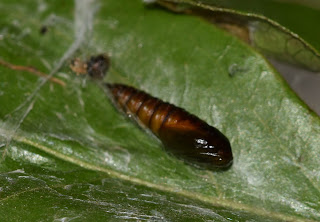 |
| 19/02/2022 |
 |
| 07/03/2022 |
 |
| 20/03/2022 |
Scientific name: Archips podana
English
name:Large fruit tree tortrix
Found
in: Serra de Collserola,
Barcelona, Spain
Scientific name: Archips podana
English
name:Large fruit tree tortrix
Found
in: Serra de Collserola,
Barcelona, Spain
Biology
A. podana has a wingspan of 17-26 mm.
According to literature (Bradley, et al., 1973, Massee, 1946, Alford, 1991), A. podana has around 2 (3 if
conditions are favorable) generations per year. The young caterpillar in the
last generation usually overwinters and in early spring continues the eating
process of the buds of their host plant.
This species is polyphagus, and has been recorded in a
wide variety of trees and shrubs (Malus,
Prunus, Betula, etc). In this
specific individual it was found in Viburnum
sp.
The larvae (as many Tortricidae
caterpillars) sticks two leaves together with silk and builds a tunnel which
allows the larvae to leave and to eat normally at the entrance of the leaf,
protected from direct predators.
The adult of this species has sexual
dimorphism, which means males and females are different in morphology. Here you can see the female of this species, which I found
some years ago.
Ecology:
Many studies have been done about
this species and its impact in the trees. Since it ättacks¨trees like Apple and
Cherry trees, it is important to control it, understand their biology and
behavior.
Even though this species attacks fruit
trees, it was shown in some studies that this species usually does not appear
concentrated in orchards, which for there is low concern when we talk about the
use of pesticides to control it (Cuthbertson and Murchie, 2005).
Portuguese:
Biologia
A. podana tem uma envergadura de
17-26 mm. De acordo com a literatura (Bradley, et al., 1973, Massee, 1946,
Alford, 1991), A. podana tem cerca de 2 (3 se as
condições forem favoráveis) gerações por ano. A lagarta na última geração
geralmente hiberna e no início da primavera continua o processo de alimentação
nas folhas recém brotadas da sua planta hospedeira.
Esta espécie é polífaga, e tem sido
registrada em uma grande variedade de árvores e arbustos (Malus, Prunus, Betula, etc). Este indivíduo específicamente foi
encontrado em Viburnum sp.
As lagartas (como muitas da
família Tortricidae) juntam duas folhas com seda e constroem um túnel que lhes
permite entradas e saídas rápidas para alimentar-se na entrada da folha,
protegidas de predadores diretos.
O adulto desta espécie tem dimorfismo
sexual, o que significa que machos e fêmeas são diferentes morfologicamente.. Aqui podem ver a fêmea desta espécie, que
encontrei há alguns anos.
Ecologia:
Muitos estudos
têm sido feitos sobre esta espécie e seu impacto nas árvores. Por atacar
árvores como macieiras e cerejeiras, é importante controlá-la, entender sua
biologia e comportamento.
Apesar de esta espécie atacar árvores
frutíferas, foi demonstrado em alguns estudos que esta espécie geralmente não
aparece de maneira concentrada em pomares, o que é pouco preocupante quando
falamos de necessidade de uso de agrotóxicos/pesticidas para controlá-la
(Cuthbertson e Murchie, 2005).
References/ Referencias:
Alford, D.V. (1991): A colour
atlas of pests of ornamental trees, shrubs and flowers. Wolfe Publishing Ltd.,
Bristol, England: 234–264.
Bradley, J. D., Tremewan, W. G. and A. Smith, British
Tortricoid Moths. Cochylidae and Tortricoidae: Tortricinae. The Ray Society,
London, 1: 102-103, 1973
Cuthbertson, A. G. S. and Murchie,
A.K., Environmental monitoring of Archips podana (fruit tree tortrix moth) in
Bramley apple orchards in Northern Ireland, Int. J. Environ. Sci. Tech, Vol. 2,
No. 2, pp. 101-104 , 2005
Massee, A. M., The Pests of Fruit and
Hops (2th. Ed.). Crosby Lockwood and Son Ltd. London,: 284, 1946
